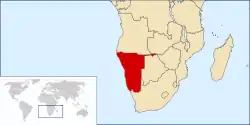United Nations Security Council Resolution 435
United Nations Security Council Resolution 435, adopted on September 29, 1978, put forward proposals for a cease-fire and UN-supervised elections in South African-controlled South West Africa which ultimately led to the independence of Namibia. Importantly, it established the United Nations Transition Assistance Group (UNTAG) which oversaw the election and the South African withdrawal.

| UN Security Council Resolution 435 | ||
|---|---|---|
 Location of Namibia | ||
| Date | 29 September 1978 | |
| Meeting no. | 2,087 | |
| Code | S/RES/435 (Document) | |
| Subject | Namibia | |
Voting summary |
| |
| Result | Adopted | |
| Security Council composition | ||
Permanent members | ||
Non-permanent members | ||
| ||
| International opposition to apartheid in South Africa |
|---|
The resolution was adopted by 12 votes to none; Czechoslovakia and the Soviet Union abstained while the People's Republic of China did not participate in the vote.
On December 22, 1988, South Africa agreed to implement the resolution upon its signature of the Tripartite Accord at the United Nations in New York. The Accord concluded an agreement on independence for Namibia, and the withdrawal of Cuban troops from Angola, and was signed by Angola, Cuba and South Africa.[1][2][3]
See also
References
- Lewis, Paul (December 23, 1988). "Angola and Namibia Accords Signed". The New York Times. Retrieved October 22, 2019.
- Wren, Christopher (December 14, 1988). "Substantive Agreement Concluded On Angola and a Free Namibia". The New York Times. Retrieved October 22, 2019.
- Wellens, Karen; T.M.C. Asser Instituut (1990). Resolutions and statements of the United Nations Security Council (1946–1989): a thematic guide. BRILL. p. 200. ISBN 978-0-7923-0796-9.
External links
 Works related to United Nations Security Council Resolution 435 at Wikisource
Works related to United Nations Security Council Resolution 435 at Wikisource- Text of the Resolution at undocs.org
- Reprint of "Namibian Voters Deny Total Power to SWAPO" by Michael Johns, The Wall Street Journal, November 19, 1989.